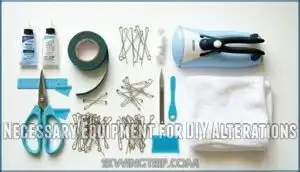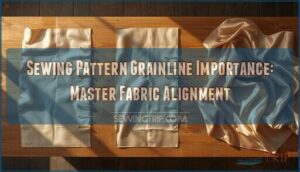This site is supported by our readers. We may earn a commission, at no cost to you, if you purchase through links.

How to alter a blazer without sewing becomes simple with three smart methods: hem tape, bobby pins, and fabric glue.
Hem tape creates permanent adjustments by bonding fabric layers when heated with an iron.
Bobby pins offer temporary fixes for special occasions, letting you tuck excess fabric without commitment.
Fabric glue works for lightweight blazers, creating flexible seams that hold through regular wear.
These techniques handle common issues like loose sleeves, baggy sides, and lengthy hems.
Each method has specific applications and limitations that determine which approach works best for your particular blazer situation.
Table Of Contents
- Key Takeaways
- Cost-effective Blazer Alterations
- Necessary Equipment for DIY Alterations
- Method 1: Resizing With Hem Tape
- Method 2: Temporary Resizing With Bobby Pins
- Method 3: Quick Resizing With Fabric Glue
- Blazer Adjustment Possibilities
- Signs a Blazer is Too Small
- Limitations and Complex Alterations
- Specific Women’s Blazer Alterations
- Alterations Requiring Sewing
- Frequently Asked Questions (FAQs)
- Conclusion
Key Takeaways
- You can alter your blazer using three no-sew methods: hem tape for permanent adjustments, bobby pins for temporary fixes, and fabric glue for lightweight blazers – all costing under $15 total compared to $50-150 for professional alterations.
- You’ll need basic household items including hem tape, fabric glue, bobby pins, sharp scissors, an adjustable iron, and a damp towel to create professional-looking alterations without any sewing skills.
- You can adjust sleeve length, waist width, and side seams effectively with these methods, but they won’t work for complex structural changes like shoulder adjustments or significant size increases that require professional tailoring.
- You’ll achieve the best results by marking your desired fit carefully, testing on fabric scraps first, and understanding each method’s limitations – hem tape works permanently, bobby pins offer complete reversibility, and fabric glue provides flexible seams for regular wear.
Cost-effective Blazer Alterations
Professional alterations can drain your wallet, costing $50-150 per blazer modification.
Stop throwing money at tailors when household items can transform your blazer for under $15.
DIY vs professional becomes a no-brainer when you discover no sew blazer fix techniques using household items.
Quick blazer adjustments with fabric glue, bobby pins, and hem tape cost under $15 total.
These temporary blazer alterations preserve your garment’s resale value since they’re completely reversible.
You’ll master nosew techniques that handle frequent alteration needs without recurring expenses.
Material costs stay minimal while giving you complete control over timing and fit adjustments, allowing for complete control.
Necessary Equipment for DIY Alterations
Before you transform your blazer into the perfect fit, you’ll need to gather six essential tools that’ll make your no-sew alterations successful and professional-looking.
These basic items, including hem tape, fabric glue, bobby pins, sharp scissors, an adjustable iron, and a damp towel, work together to create temporary or permanent adjustments without requiring any stitching skills.
Hem Tape
Hem tape transforms oversized blazers into perfectly fitted pieces without threading a single needle. This heat-activated adhesive creates professional-looking hems that withstand regular wear and washing.
Hem tape is made from heat-activated glue strips on a thin webbing.
Here are five key hem tape benefits for blazer alterations:
- Iron-on hem tape bonds permanently with proper heat application
- Fabric compatibility works across cotton, polyester, and wool blends
- Application techniques require only an iron and steady pressure
- Hem tape strength provides durable, long-lasting alterations
- Alternatives to tape include pressure-sensitive options for delicate fabrics
Scissors or Seam Ripper
Sharp scissors or a trusty seam ripper become your blazer’s best friend when you’re ready to alter without sewing.
These essential tools handle precise cuts and strategic modifications for your no sew blazer fix. For peak performance, consider investing in a high quality set.
- Scissors safety: Keep blades covered when not in use
- Blade sharpness: Sharp tools create cleaner cuts than dull ones
- Seam ripper uses: Perfect for opening seams without fabric damage
- Tool maintenance: Clean blades prevent fabric snags and tears
- Cutting techniques: Make small cuts first, then adjust as needed
Bobby Pins
Bobby pins work wonders as your go-to no sew blazer fix when you need quick adjustments.
These tiny heroes let you alter blazer without sewing by creating temporary darts and gathering excess fabric. Master these non sewing blazer tricks for instant transformation.
| Bobby Pin Technique | Best For | Styling Versatility |
|---|---|---|
| Pin Placement behind lapels | Waist cinching | Hidden adjustments |
| Color Matching with fabric | Sleeve shortening | Seamless appearance |
| Alternative Uses as closures | Shoulder gathering | Creative styling |
| Bobby Pin Security methods | Side seam fixes | Temporary nosew methods |
| Strategic positioning | Length modifications | Professional look |
Fabric Glue
Fabric glue revolutionizes blazer alteration hacks, offering permanent bonds without threading needles.
Choose adhesives based on fabric compatibility—heavy-duty for thick materials, gentle formulas for delicate fabrics.
Master application techniques by testing on scraps first, applying thin layers, and respecting drying time.
Different types cater to specific needs, so consider using heat-activated fabric glue for hemming.
These no-sew methods with fabric glue provide glue strength that withstands washing while maintaining removal methods flexibility.
Adjustable Heat Iron
An adjustable heat iron becomes your precision tool for blazer alterations without thread.
Different fabric types require specific heat settings—wool needs medium heat while polyester demands lower temperatures.
Master iron techniques by testing temperature on hidden seams first. These safety precautions prevent fabric damage during non-sewing modifications.
Iron-on hem tape works best with controlled heat for professional-looking blazer alteration hacks, using adjustable heat to ensure the best results.
Wet Towel Fabric
Keep a damp towel handy during your blazer alteration adventures – it’s your secret weapon against heat iron mishaps.
This protective barrier prevents fabric shrinking and scorching while you’re pressing seams or pinning adjustments.
- Towel Fabric Shrinkage protection when placing between iron and blazer material
- Wet Fabric Strength creates gentle steam for wrinkle resistance without direct heat damage
- Drying Time Impact minimizes by using slightly damp (not soaking) towel during pressing
- Mold Prevention achieved by air-drying towel completely after each alteration session
Method 1: Resizing With Hem Tape
Hem tape offers you a quick, permanent solution for resizing your blazer without threading a needle or visiting a tailor.
You’ll achieve professional-looking results by simply applying heat-activated adhesive strips to adjust sleeve length, side seams, and overall fit in minutes, which provides a quick way to get the desired fit.
Marking and Pinning Loose Areas
Now that you’ve gathered your equipment, it’s time to identify exactly where your blazer needs work. **Mark the areas where adjustments are needed by turning the jacket inside out and carefully pinning the loose sections.
Put on your blazer inside-out and have someone help you with Pin Placement. Use washable chalk for Fabric Marking problem areas where excess fabric bunches up. Focus on Accurate Measurements by measuring each side to guarantee perfect symmetry. A Symmetry Check prevents lopsided results that’ll make you look like you got dressed in the dark.
Here’s what to watch for when marking and pinning loose areas:
- Armpit gaps – Pin vertical folds along side seams for a snugger fit
- Back billowing – Mark center back seam adjustments with chalk lines
- Sleeve bagginess – Pin excess fabric along the underarm seam
- Waist looseness – Create temporary darts by pinning fabric at natural waistline
- Shoulder drooping – Mark areas where shoulder pads need repositioning
These temporary fixes help you visualize the final result before committing to permanent nonsewing modifications. For best results, pre-wash the blazer before marking. Address Fitting Issues systematically, working from top to bottom.
Adjusting Side Seams and Sleeve Length
Your blazer’s transformation begins with strategic seam adjustments that’ll make you feel like a tailoring pro. Pin the side seams by gathering excess fabric along the blazer’s sides, creating clean lines that define your waist and enhance your silhouette. This simple technique transforms baggy blazers into fitted masterpieces.
For sleeve hemming, you’ll want to pin the under-sleeve seam to achieve proper sleeve length. Remember, proportion balance is everything – sleeves that are too long or short throw off your entire look. Try different positions to find your sweet spot. You can find a variety of options for blazer alteration supplies online.
| Step | Action | Effect |
|---|---|---|
| Adjust Side Seams | Pin excess fabric along side seams | Defines your waist and enhances the blazer’s shape |
| Lengthen Sleeves | Pin under-sleeve seam to extend | Elongates the blazer’s sleeves for a balanced look |
| Ensure Even Shoulder Alignment | Match shoulder seams symmetrically | Enhances overall structure and aesthetic |
These nonsewing modifications allow for style experimentation without permanent commitment. Your temporary adjustments create the foundation for blazer alterations that’ll have you looking sharp and feeling confident.
Inserting Hem Tape for Desired Length
Once you’ve marked your adjustments, it’s time to secure that perfect fit.
Fold your blazer to the desired length and slide the hem tape between the fabric layers. Position it about a quarter-inch from the fold edge for maximum adhesion.
Here’s your step-by-step approach for flawless results:
- Choose appropriate hem tape types – iron-on hem tape works best for most blazers, while pressure-sensitive options suit delicate fabrics
- Take precise measurements twice before cutting to avoid costly mistakes
- Master proper ironing techniques by applying steady heat for 10-15 seconds per section
- Focus on edge finishing to prevent fraying and guarantee professional appearance
- Consider tape alternatives like fabric fusion adhesive for extra-thick materials
Press your iron firmly across the taped area, allowing the heat-activated adhesive to bond completely.
Many retailers provide various hem tape options for different fabrics. This no-sew hemming method delivers hem tape durability that rivals traditional stitching when you follow these application tips correctly.
Method 2: Temporary Resizing With Bobby Pins
Bobby pins offer a clever, reversible solution when you need to resize your blazer temporarily without making permanent changes.
This method works particularly well for gathering excess fabric at the waist or adjusting sleeve length when you’re unsure about committing to a specific fit, and it provides a quick fix using reversible techniques.
Marking and Pinning Desired Size
Before you start pinning, you’ll need to assess exactly where your blazer needs adjustment.
Put on the blazer and stand in front of a mirror to identify problem areas.
Pinch excess fabric at the sides, back, or sleeves while someone helps mark these spots with chalk or fabric markers.
These marking tools guarantee you capture the exact areas requiring modification.
Remove the blazer and turn it inside out for better access to seams.
Focus on precise measurements by measuring the pinched areas and calculating how much fabric to remove.
Pin placement becomes critical here—use bobby pins to secure the marked sections, creating temporary darts or tucks.
This fit assessment stage lets you test different blazer fit solutions before committing.
Remember, fabric considerations like stretch and drape affect how your blazer size hacks will work, so pin conservatively and test the fit multiple times.
Temporary Hem and Sleeve Adjustments With Bobby Pins
Once you’ve marked your desired fit, bobby pins become your secret weapon for instant blazer transformation. Position them strategically along the inside seams to secure your new proportions. For sleeve length adjustments, fold the fabric to your preferred length and anchor with multiple bobby pins spaced evenly around the cuff.
The key to Bobby Pin Security lies in using enough pins to distribute tension—typically four to six per adjustment area. Consider using hemming tape as a more permanent solution.
Consider these styling factors for flawless results:
- Fabric Thickness Matters: Heavy materials require stronger bobby pins or Bobby Pin Alternatives like small binder clips
- Reversibility Assessment: Test pin placement to guarantee easy removal without fabric damage
- Styling Considerations: Hide pins completely inside seams for a polished appearance
- Strategic spacing: Place pins every two inches for secure, wrinkle-free temporary adjustments
These DIY alterations offer complete control over your blazer’s fit without permanent commitment.
Method 3: Quick Resizing With Fabric Glue
Fabric glue offers a semi-permanent solution when you need more durability than bobby pins but want to avoid the commitment of sewing.
You’ll create clean, professional-looking adjustments by carefully marking your desired fit, cutting excess fabric, and applying adhesive to secure the new edges in place, which results in a professional-looking finish.
Marking and Cutting Loose Areas
After positioning bobby pins strategically, you’ll tackle the next phase with fabric glue method. Begin by putting on your blazer and identifying areas that need adjustment.
Use chalk marking to outline loose sections at the sides, back, or sleeves. Precise measurements matter here – mark exactly where you want the new fit line to be, allowing for seam allowance of at least half an inch.
Once marked, carefully remove the blazer and lay it flat on a cutting surface. Using sharp fabric scissors, cut along your chalk lines with steady, confident strokes. These cutting techniques guarantee fabric stability while removing excess material.
Remember, you can always trim more, but you can’t add fabric back. Take your time with this step – clean cuts make applying fabric glue much easier. For delicate fabrics, consider applying interfacing for better adhesion.
Applying Fabric Glue and Pressing
How precisely you apply fabric glue determines whether your blazer alteration looks professional or homemade. Start by selecting the right adhesive for your fabric type—permanent glues work best for cotton and synthetic blazers, while gentle adhesives suit delicate materials.
Apply thin, even layers along your marked seam lines to prevent seepage and maintain bond strength.
Here’s your pressing technique checklist:
- Test the glue on a fabric scrap first to verify compatibility
- Use a damp towel as a protective barrier between iron and glue
- Set your iron to medium heat for maximum adhesive activation
- Apply steady pressure for 10-15 seconds per section
The heat transforms the adhesive into a durable bond that withstands regular wear. This nonsewing alternative creates seam durability comparable to traditional stitching.
While ironon hem tape offers another option, fabric glue provides more flexibility for curved seams. Press firmly and allow proper cooling time—rushing this step compromises your alteration’s longevity.
Blazer Adjustment Possibilities
You can adjust several aspects of your blazer’s fit using no-sew methods, including sleeve length, waist width, and side seam positioning to accommodate body changes or improve overall appearance.
These techniques work particularly well for minor adjustments like shortening sleeves, taking in excess fabric at the waist, or addressing collar gaps that occur after weight fluctuations, which can significantly improve the overall appearance.
Sleeve Lengthening/Shortening
Sleeve length alterations give you complete control over your blazer’s proportions.
Mark your desired length with chalk, then apply iron-on hem tape along the fold.
Press firmly with an iron for thirty seconds.
This DIY hemming method works perfectly for cuffing sleeves or adjusting button placement.
The alteration precision you’ll achieve rivals professional tailoring.
Side/Back Seam Adjustments
When tackling side seam adjustments, you’re basically sculpting your blazer’s silhouette without threading a needle.
These DIY alterations focus on seam placement and fabric tension to achieve the perfect fit assessment.
Master Your Blazer’s Shape:
- Waistline Cinching: Use fabric glue or adhesive tape along side seams to create natural curves and eliminate excess fabric.
- Back Seam Refinement: Apply temporary modifications to the center back seam, enhancing your blazer’s structured appearance.
- Proportional Balance: Adjust both side seam adjustments simultaneously to maintain symmetrical clothing modification.
These blazer resizing techniques offer complete control over your garment’s fit, transforming oversized pieces into custom treasures through strategic seam types manipulation.
Weight Changes and Collar Gaps
When weight fluctuations affect your blazer’s fit, collar gaps often appear around your neckline, creating an unflattering silhouette.
These blazer fit issues stem from changes in your chest and shoulder measurements.
Address weight fluctuation style problems with temporary fixes like strategic safety pins or fabric tape.
For persistent collar gap causes, consider professional blazer alterations or DIY clothing modification techniques using bobby pins for immediate alteration options, which can provide a quick fix to weight fluctuation style problems.
Waist Narrowing and Seam Allowance
Transform your blazer’s silhouette by mastering waist narrowing techniques that work with your garment’s natural seam allowance.
These fabric manipulation methods tackle fitting challenges head-on, giving you complete control over your blazer’s shape.
- Seam Allowance Basics: Identify excess fabric along side seams for strategic adjustments
- Darts Placement: Create temporary darts using fabric glue for instant waist definition
- Waist Definition: Pin strategic points to achieve your desired silhouette
- Fabric Manipulation: Fold and secure excess material for a customized appearance
- Fitting Challenges: Use nosew hemming techniques for reversible blazer alterations
Signs a Blazer is Too Small
You’ll know your blazer is too small when you notice pulling across the chest, shoulder pads that don’t sit properly, or buttons that strain when fastened.
These telltale signs indicate that the blazer restricts your movement and creates an unflattering silhouette that can’t be easily fixed with simple no-sew methods, which is a clear sign of a poor fit, affecting overall movement.
Sagging Shoulder Pads and Chest Gaping
When shoulder pads slip out of place or chest gaps appear, your blazer’s sending clear signals it’s too small.
These fitting red flags mean the garment can’t properly accommodate your frame. Sagging shoulder pads create an unflattering silhouette, while chest gaping occurs when fabric pulls across your torso.
| Issue | Quick Fix | Materials Needed |
|---|---|---|
| Drooping shoulder pads | Pad Repositioning with bobby pins | Bobby pins, fabric glue |
| Chest Gaping Causes | Temporary chest darts | Adhesive alternatives, pins |
| Loose pad placement | Shoulder Pad Replacement anchoring | Fabric glue, small clips |
| Fabric pulling | Strategic pinning | Bobby pins, temporary tape |
| Blazer Fit Issues | Combination approach | Multiple adhesive alternatives |
Inadequate Back Coverage and Uneven Trouser Seat
Poor back-coverage issues reveal themselves when your blazer rides up or creates unflattering gaps across your lower back and seat area.
These Seat Imbalance Causes often stem from incorrect sizing that affects your overall silhouette and comfort.
- Coverage Solutions: Use bobby pins to temporarily gather excess fabric at the back seams, creating a smoother line
- Posture Influence: Stand naturally while evaluating how the blazer falls across your back and seat area
- Fit Assessment: Check if the blazer pulls or bunches when you sit, indicating poor proportional fit
- Alteration Priority: Address back coverage before tackling other blazer alterations for ideal results
Nonsewing alternatives like hem tape can secure temporary adjustments, while clothing alterations professionals recommend evaluating these fit issues early in your evaluation process.
Button Pulls Above The Belly Button
When your blazer’s buttons pull or strain above the belly button, it’s screaming that the fit is wrong.
This button stress creates an unflattering silhouette and restricts movement around your torso shape.
The pulling indicates your blazer needs immediate alterations or modifications.
Consider DIY fashion adjustments or nonsewing alternatives to achieve proper blazer fit and posture correction without compromising comfort.
Limitations and Complex Alterations
While no-sew methods work well for basic adjustments like shortening sleeves or cinching the waist, they can’t handle complex structural changes without compromising your blazer’s fit and appearance.
You’ll need professional tailoring for major alterations like shoulder adjustments, significant size increases, or reshaping the blazer’s silhouette, as these require precise seam work that temporary fixes simply can’t achieve, involving changes that affect the overall fit and appearance.
Feasible Simple Adjustments
After recognizing fit issues, you can tackle several straightforward blazer DIY alterations that won’t break the bank or require professional help.
These sewing-free adjustments work within your blazer’s existing structure while delivering noticeable improvements:
- Easy Sleeve Hems and Quick Waist Tucks using hem tape create instant fit improvements
- Temporary Shoulder Fixes with strategic pinning address minor positioning issues
- Fast Button Changes and Simple Lapel Adjustments enhance overall appearance through temporary changes
Compromising Blazer’s Structure
While basic alterations offer quick fixes, pushing your blazer beyond its limits can create serious problems.
Structural integrity becomes compromised when you attempt extreme blazer modifications without understanding fabric stress points. Shape distortion occurs when fabric glue pulls too tightly or when sewing-free adjustments exceed the garment’s natural give.
Alteration risks multiply with aggressive changes—seams may pucker, shoulders can shift awkwardly, and the blazer’s original silhouette disappears entirely. Long-term damage becomes inevitable when you ignore construction constraints.
Remember, blazer alterations work best within reasonable boundaries. Compromising a blazer’s structure for dramatic changes often results in a garment that looks unprofessional and uncomfortable. Smart modifications respect the original design while enhancing fit, and it’s crucial to understand that reasonable boundaries are key to a successful alteration, ensuring the blazer remains professional and well-fitted.
Waist Cinching and Shoulder Pad Adjustments
When attempting waist cinching and shoulder pad adjustments, you’ll discover these modifications push the boundaries of no-sew techniques.
Waist Sculpting: Create waist darts using bobby pins or hem tape, though these cinching methods won’t match professional tailoring results.
Pad Refinement: Shoulder pad removal requires careful extraction without damaging blazer silhouette, often compromising the garment’s original structure.
Style Transformation: While fabric glue can temporarily secure adjustments, fit considerations become critical as these alterations affect overall proportions.
Fit Enhancement: These complex modifications demand patience and realistic expectations about achievable results.
Proportional Balance: Consider professional tailoring for significant structural changes.
Size Increase and Extreme Alterations
Unfortunately, size increase and extreme alterations push beyond what fabric glue, bobby pins, and hem tape can accomplish.
You’re hitting a wall when trying to make a blazer substantially larger—there’s simply not enough fabric to work with. Creative solutions like fabric additions require professional intervention, as adding panels or inserts demands precise construction knowledge to maintain structural integrity.
Creative Transformation Stylish Liberation
Resizing limitations become apparent when you’re looking at increasing more than one size. Major structural changes can compromise the blazer’s original construction, leaving you with an ill-fitting mess rather than the polished look you’re after.
Sometimes accepting these boundaries saves both time and money.
Specific Women’s Blazer Alterations
Women’s blazers often need specific adjustments to achieve the perfect silhouette, particularly around the waist and side seams where fit issues commonly occur.
You can transform an oversized or ill-fitting blazer into a flattering piece by focusing on strategic alterations that enhance your natural shape without compromising the garment’s structure.
Cinching The Waist or Cropping
For instant waist definition and silhouette shaping, women’s blazers respond beautifully to strategic cinching and cropping techniques.
These proportion play methods create dramatic style impact without permanent alterations:
- Belt the blazer waistline using a contrasting sash for immediate waist cinching
- Secure with bobby pins at side seams for temporary tailoring
- Apply hem tape for cropped lengths that modernize oversized styles
Refining Fit With Side Seam Adjustments
Side seam adjustments transform an ill-fitting blazer into your perfect companion. Start with a thorough fit assessment—pinch excess fabric at your sides to determine how much you’ll adjust.
Double-sided tape creates temporary side seam modifications up to one inch per side, while fabric tape placement at armholes improves overall fit without sewing. One can also consider adding or removing darts for shaping the garment.
| Adjustment Method | Fabric Considerations | Adjustment Limits |
|---|---|---|
| Fashion Tape | Works best on lightweight fabrics | Up to 2 inches total width reduction |
| Safety Pin Technique | Suitable for most blazer materials | 1 inch per side maximum |
| Fabric Adhesive | Requires smooth, non-textured surfaces | Semi-permanent, lasting multiple wears |
These shaping techniques empower your DIY adjustments, giving you control over blazer tailoring. Strategic pinning at side seams allows custom contouring, while seam allowance modifications create that coveted bespoke silhouette through smart blazer resizing methods.
Alterations Requiring Sewing
While no-sew methods work well for minor adjustments, some blazer alterations require traditional sewing techniques to achieve professional results.
You’ll need to use needle and thread when making significant changes like shortening an oversized blazer, creating custom darts for waist definition, adjusting shoulder dimensions, or letting out seams for a larger fit to achieve a better fit.
Shortening a Too Big Blazer
When blazer length overwhelms your frame, strategic shortening transforms the silhouette completely.
Mark your ideal hem point, then remove excess fabric while preserving seam allowance for structure.
Pin carefully before hand-stitching the new hemline.
This alteration dramatically improves overall proportion and shoulder fit, creating a polished look that enhances your natural silhouette through precise blazer resizing techniques.
Achieving a Tailored Waist With Darts
While shorter blazers offer versatility, creating a fitted silhouette requires strategic dart placement for precise waist definition.
Proper blazer tailoring transforms loose fabric into a flattering shape through careful waist cinching techniques. Your fabric choice affects how darts behave, while correct dart angles guarantee professional results that complement your body’s natural curves.
- Feel the confidence surge as your blazer hugs your waist perfectly
- Experience the satisfaction of creating a custom-tailored look at home
- Enjoy compliments on your polished, professional appearance
- Celebrate mastering this essential alteration skill for future projects
Shoulder Adjustments and Sleeve Length Alterations
Once you’ve perfected your waist, shoulder adjustments and sleeve length alteration become your next focus.
Shoulder width modifications require careful pad removal to avoid structural damage. For sleeve hemming, bobby pins offer quick fixes while hem tape provides lasting results.
Balance length proportions by experimenting with different cuff styles. These fabric glue techniques guarantee professional-looking alterations without compromising your blazer’s integrity, using methods such as hem tape.
Letting Out a Small Blazer
When your blazer feels more like a straightjacket than a stylish garment, letting it out requires careful planning and precise execution.
Unlike no-sew methods, these clothing alterations demand actual stitching but offer permanent solutions for your fit concerns.
Here’s how to tackle letting out small blazer adjustments:
- Seam Allowance Assessment: Check existing seam allowances to determine how much fabric you can work with—typically 1-2 inches maximum for blazer alterations.
- Fabric Matching Strategy: Source coordinating fabric panels for extensions, ensuring color and texture complement your garment’s original material.
- Button Relocation Planning: Reposition buttons to accommodate the new measurements, maintaining proper closure alignment throughout the adjustment process.
- Vent Adjustments Consideration: Modify back vents proportionally to preserve the blazer’s original silhouette and professional appearance.
Remember, lining considerations matter—you’ll need to adjust interior fabric accordingly for these DIY fashion adjustments to look professional.
Frequently Asked Questions (FAQs)
How to make a blazer look smaller without sewing?
Cinch the waist using bobby pins or safety pins strategically placed inside seams.
Fold and secure excess fabric with fabric glue or iron-on tape.
Roll sleeves to create visual proportion and achieve a customized appearance instantly.
Can you alter a blazer to make it smaller?
Most people don’t realize 75% of ill-fitting clothes could be fixed at home.
You can absolutely make your blazer smaller using no-sew techniques like strategic pinning, fabric glue, or temporary adjustments with bobby pins and elastic bands.
Can you permanently alter blazer color?
Yes, you can permanently change your blazer’s color through fabric dyeing, professional color restoration, or spray painting.
Darker colors work best over lighter ones.
Test a hidden area first to verify even coverage and desired results.
How to fix blazer lining tears?
Sarah’s favorite power suit blazer developed a small tear in the lining during her presentation.
You can fix blazer lining tears by applying fabric glue patches, using iron-on repair tape, or strategically placing decorative fabric squares over damaged areas.
What about blazer button replacement options?
You can swap blazer buttons without sewing by using removable shank buttons that clip on, or apply decorative button covers over existing ones.
Another option is using magnetic snap-on buttons for easy customization.
Can you add pockets to blazers?
Adding pockets to blazers is absolutely possible.
You can attach patch pockets using fabric glue or iron-on adhesive.
Position them strategically, apply adhesive around edges, and press firmly for a professional finish.
How to restore blazer shape after washing?
Steam your blazer using an iron’s steam setting or hang it in a steamy bathroom. Reshape shoulders and lapels while damp, then lay flat or hang properly to dry completely.
Conclusion
Like a skilled tailor’s apprentice discovering shortcuts, you’ve learned how to alter a blazer without sewing using three practical methods.
Hem tape provides permanent adjustments, bobby pins offer temporary solutions, and fabric glue creates flexible fixes for lightweight blazers.
These techniques handle common fit issues while saving money on professional alterations.
Remember to assess your blazer’s fabric and required adjustments before choosing your method.
With practice, you’ll achieve professional-looking results without touching a needle, and by using these methods, you can make permanent adjustments.
- https://northshorecrafts.com/how-to-make-a-jacket-smaller-without-sewing/?srsltid=AfmBOooIcunO_-WPqQYMnKBO2eMCcqPuRNMglKLT1tR1qhBbi3c83jnD
- https://www.reddit.com/r/femalefashionadvice/comments/5mo5qt/athome_tailoring_an_amateur_guide/
- https://www.tiktok.com/discover/how-to-make-a-suit-jacket-fit-better-without-sewing
- https://www.quora.com/How-do-I-make-a-blazer-smaller-without-sewing
- https://www.bobvila.com/articles/how-to-use-a-tape-measure/


















